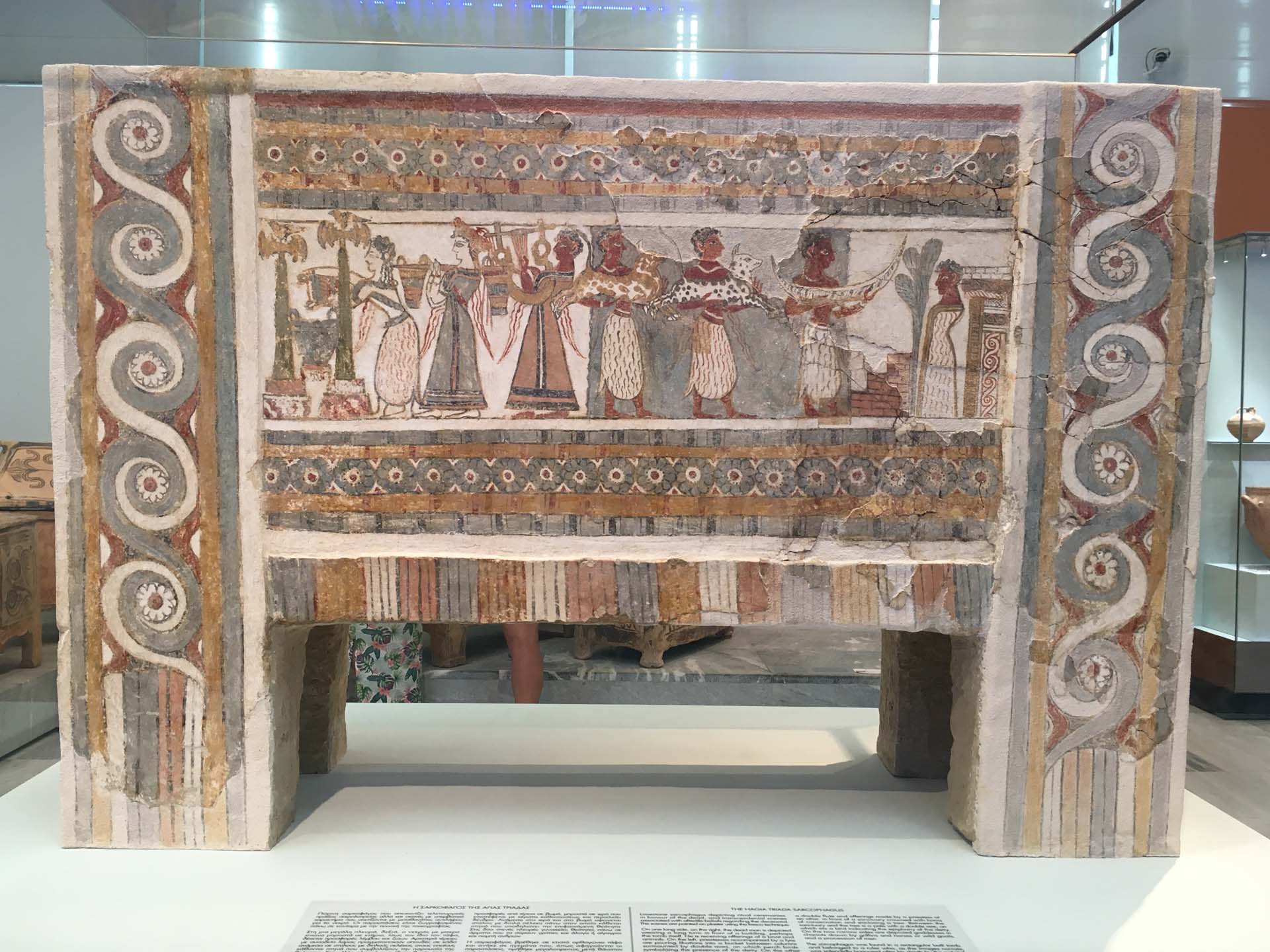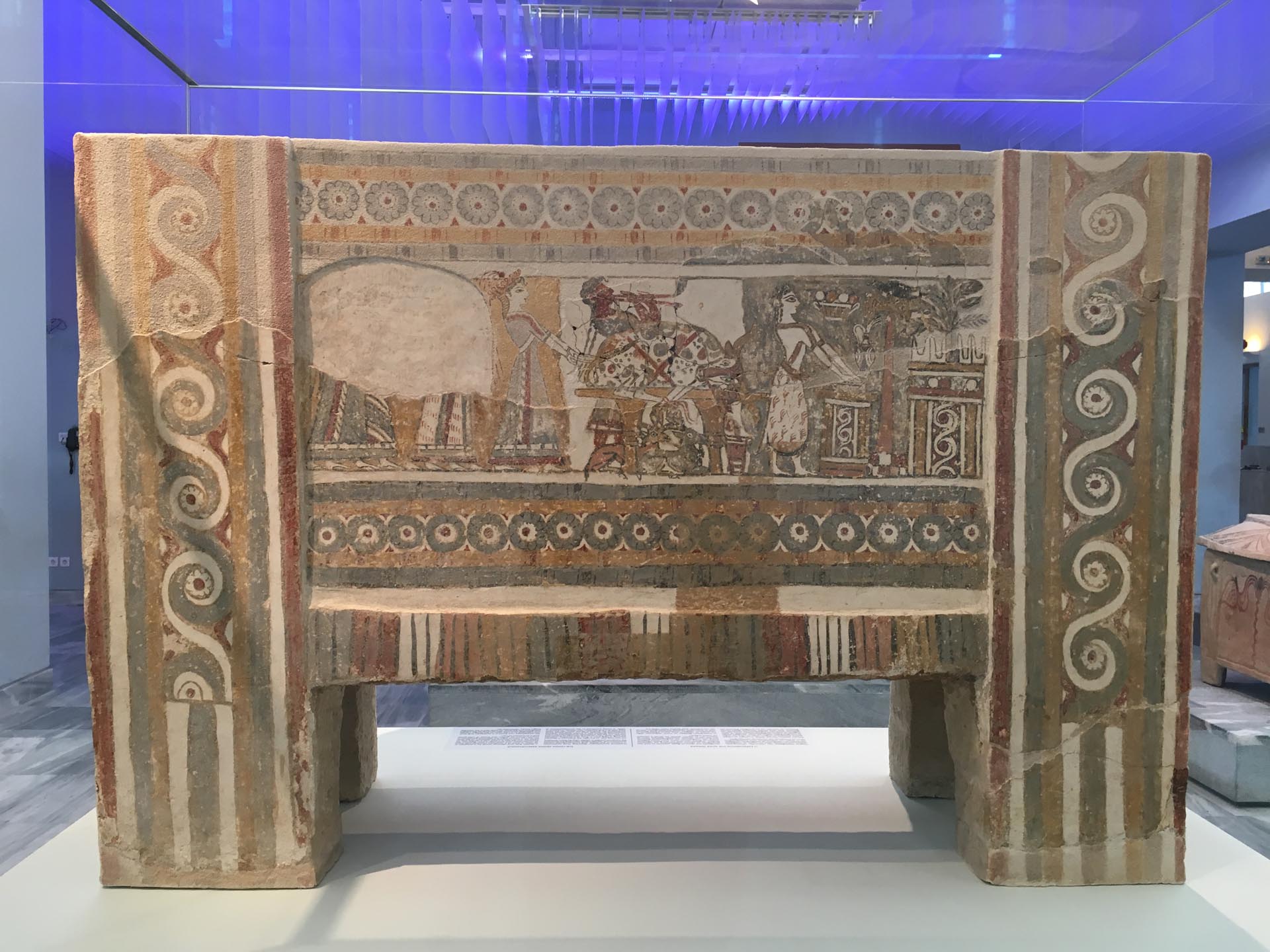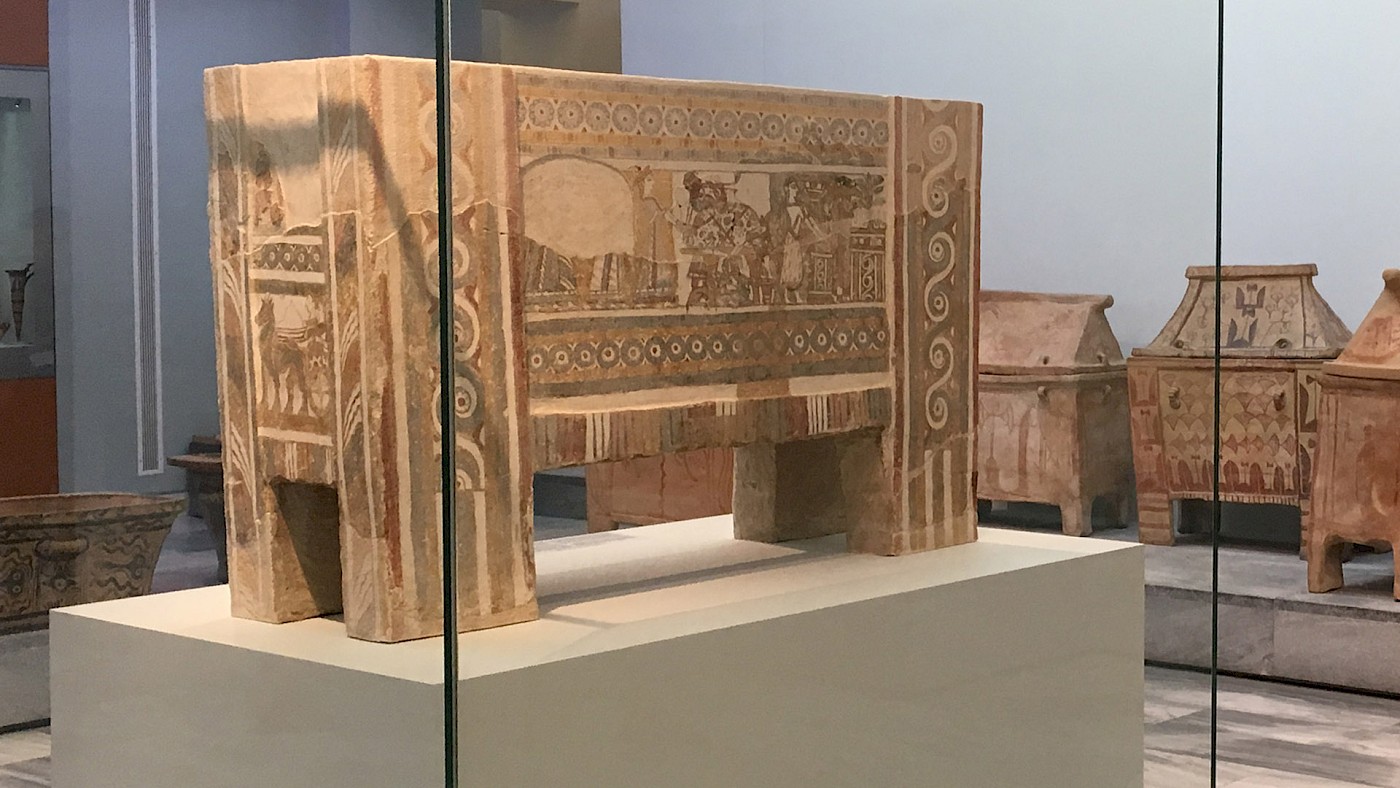From tomb 4, a well-built chamber tomb located to the northeast of the Minoan “villa” at Agia Triada, comes a remarkable limestone sarcophagus. The sarcophagus was unearthed at the beginning of the twentieth century and measures ca. 137 cm in length. It originally contained the remains of a high-status individual. It dates to around 1400 BC, so from the Third (Final) Palace Period, when all of the Minoan palaces except Knossos had been destroyed and a Mycenaean (or Mycenaeanizing?) presence is attested at major centres, including Knossos and Agia Triada.
In overall shape and function it resembles the clay larnakes that were used throughout much of the second millennium as coffins and, sometimes, storage containers. The Agia Triada sarcophagus occupies pride of place among the larnakes on display in one of the rooms on the ground floor of the archaeological museum of Iraklion. However, larnakes were normally made of clay, rather than limestone. While in use from the First Palace Period (ca. 1925/1900-1750/1700 BC) onwards, they become especially popular during the Third Palace Period (i.e. after ca. 1470/1460 BC).
A larnax usually has four (shortish) legs, but some feature another pair of legs in the middle of their long sides. They were either box-shaped, with square corners, like the limestone sarcophagus, or tub-shaped, with rounded corners. They often feature painted decoration, with depictions of different types of animals, such as octopuses and agirimia (wild goats). Larnakes usually have gabled lids that fit snuggly, but the Agia Triada sarcophagus doesn’t have a lid. Holes in the bottom allowed liquids from the decomposing corpse to drain away.

The sarcophagus features painted figurative scenes on the outside of each of its four sides. On both of the long sides, the background is divided into three more or less equal parts, each with a different colour, but the significance of these colours isn’t clear. At far left, there’s a large bucket (or rhyton?) fixed between two standing double-axes. A woman with white skin pours a liquid into the “bucket”. There is another woman behind her who carries two other buckets on her shoulders, probably ready for the first woman to take them and pour them between the axes. The third figure from the left, with darker skin, is a lyre-player, so music was part of this ritual.
In the centre of this long panel are three men (with dark skin). The first two appear to be carrying small bulls (perhaps rhyta? See Paul Rehak and John G. Younger, “Neopalatial, Final Palatial, and Postpalatial Crete”, in: Tracey Cullen (ed.), Aegean Prehistory: A Review (2001), p. 447), the third one has a model of a ship. In their book Aegean Art and Architecture (1998), Donald Preziosi and Louise Hitchcock suggest that these are “models of sacrifical animals, and a model of a boat,” which were “possibly for deposit in the tomb itself […] – a practice common in contemporary Egypt” (p. 179). They appear to be carrying their offerings toward the male, armless figure at extreme right, who is standing in front of a shrine or tomb. This male figure probably represents the deceased.

The other long side of the sarcophagus has sustained damage, but it shows a procession heading from left to right. At the extreme right is an altar and a shrine. The shrine has “Horns of Consecration” on the roof; there’s a palm tree behind the shrine. The procession features women, all with white skin, and a dark-skinned, male flautist. The woman at the far right is handling a pot that appears to have been placed on a fire on the altar.
The flautist passes behind a trussed bull. Its throat has apparently been cut, as blood is depicted flowing from the neck and collected in a rhyton beneath the table; the animal’s eyes appear to look directly at you and elicit pathos on the part of the modern viewer. Two small, wide-eyed deer are depicted beneath the sacrificial table; perhaps they are next? The woman following the flute player looks like she’s about to put her hands on the table.

The short sides of the sacrophagus each show a similar scene: two women in a chariot pulled by different animals. In one case, the animal in question looks at first blush like an equid, but may instead be a goat (Rehak and Younger, op. cit., suggest “agrimia altered from horses”, p. 447); in the other case, the animal (animals?) is a griffin. The latter panel also feature a tiny griffin flying overhead.
The presence of fantastical creatures suggests the supernatural; griffins are also encountered in Minoan and Mycenaean wall-painting where they seem to be connected to the gods. And while the painter only indicated the presence of a single animal, we know that chariots were always drawn by a team of two. Naturally, real-life chariots were drawn by horses.
The scenes on the sarcophagus presumably all connect to burial rituals and/or the commemoration of the dead. Like, for instance, Classical lekythoi, such as this example from Attica, the sarcophagus was specifically made for funerary purposes, and the figurative scenes would logically be connected with burial rituals and ceremonies. The inclusion of a bull sacrifice is particularly noteworthy. As Paul Rehak and John G. Younger note in their chapter, “Neopalatial, Final Palatial, and Postpalatial Crete”, in Tracey Cullen’s Aegean Prehistory: A Review (2001), pp. 457:
A major development of the Final Palatial Period is the evidence for bull sacrifice; it is possible that the killing of the animal now becomes the final feature of the Minoan bull-games, perhaps under Mycenaean influence. It may be significant too that the bull sacrifice is attested at exactly the moment when the new iconographic topos of the Minotaur appears on seals. If the minotaurs represent men in masks, they may be appropriating some of the powers associated with the bull for symbolic, even shamanistic purposes. Women still played an important role in religion, however, as the the Knossos Procession Fresco, Ayia Triada sarcophagus, and Archanes Tholos A all demonstrate.
It’s a little hard to imagine how else the bull-games could have ended if not with the sacrifice of the bull; I suppose it could be possible that bulls were released back into the wild during the Neopalatial and earlier periods. Nevertheless, the Agia Triada sacrophagus provides a valuable glimpse into religious practices during the Late Bronze Age in at least this region of Crete, which aside from differences is also characterized by continuity with regards to e.g. the prominence of women in cult, and the persistence of Minoan symbols like the “Horns of Consecration”. (For more, see esp. Brendan Burke, “Materialization of Mycenaean ideology and the Ayia Triada Sarcophagus”, American Journal of Archaeology 109.3 (2005), pp. 403-422.)
